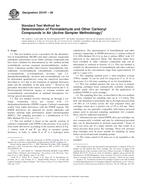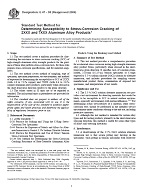1.1 This test method covers the determination of creep-fatigue crack growth properties of nominally homogeneous materials by use of pre-cracked compact type, C(T), test specimens subjected to uniaxial cyclic forces. It concerns fatigue cycling with sufficiently long loading/unloading rates or hold-times, or both, to cause creep deformation at the crack tip and the creep deformation be responsible for enhanced crack growth per loading cycle. It is intended as a guide for creep-fatigue testing performed in support of such activities as materials research and development, mechanical design, process and quality control, product performance, and failure analysis. Therefore, this method requires testing of at least two specimens that yield overlapping crack growth rate data. The cyclic conditions responsible for creep-fatigue deformation and enhanced crack growth vary with material and with temperature for a given material. The effects of environment such as time-dependent oxidation in enhancing the crack growth rates are assumed to be included in the test results; it is thus essential to conduct testing in an environment that is representative of the intended application.
1.2 Two types of crack growth mechanisms are observed during creep/fatigue tests: (1) time-dependent intergranular creep and (2) cycle dependent transgranular fatigue. The interaction between the two cracking mechanisms is complex and depends on the material, frequency of applied force cycles and the shape of the force cycle. When tests are planned, the loading frequency and waveform that simulate or replicate service loading must be selected.
1.3 Two types of creep behavior are generally observed in materials during creep-fatigue crack growth tests: creep-ductile and creep-brittle (1). In creep-ductile materials, creep strains dominate and creep-fatigue crack growth is accompanied by substantial time-dependent creep strains near the crack tip. In creep-brittle materials, creep-fatigue crack growth occurs at low creep ductility. Consequently, the time-dependent creep strains are comparable to or less than the accompanying elastic strains near the crack tip.
1.3.1 In creep-brittle materials, creep-fatigue crack growth rates per cycle or da/dN, are expressed in terms of the magnitude of the cyclic stress intensity parameter, ΔK. These crack growth rates depend on the loading/unloading rates and hold-time at maximum load, the force ratio, R, and the test temperature (see Annex A1 for additional details).
1.3.2 In creep-ductile materials, the average time rates of crack growth during a loading cycle, (da/dt)avg, are expressed as a function of the average magnitude of the Ct parameter, (Ct)avg (2).
Note 1 – The correlations between (da/dt)avg and (Ct)avg have been shown to be independent of hold-times (2, 3).
1.4 The crack growth rates derived in this manner and expressed as a function of the relevant crack tip parameter(s) are identified as a material property which can be used in integrity assessment of structural components subjected to similar loading conditions during service and life assessment methods.
1.5 The use of this practice is limited to specimens and does not cover testing of full-scale components, structures, or consumer products.
1.6 This practice is primarily aimed at providing the material properties required for assessment of crack-like defects in engineering structures operated at elevated temperatures where creep deformation and damage is a design concern and are subjected to cyclic loading involving slow loading/unloading rates or hold-times, or both, at maximum loads.
1.7 This practice is applicable to the determination of crack growth rate properties as a consequence of constant-amplitude load-controlled tests with controlled loading/unloading rates or hold-times at the maximum load, or both. It is primarily concerned with the testing of C(T) specimens subjected to uniaxial loading in load control mode. The focus of the procedure is on tests in which creep and fatigue deformation and damage is generated simultaneously within a given cycle. It does not cover block cycle testing in which creep and fatigue damage is generated sequentially. Data which may be determined from tests performed under such conditions may characterize the creep-fatigue crack growth behavior of the tested materials.
1.8 This practice is applicable to temperatures and hold-times for which the magnitudes of time-dependent inelastic strains at the crack tip are significant in comparison to the time-independent inelastic strains. No restrictions are placed on environmental factors such as temperature, pressure, humidity, medium and others, provided they are controlled throughout the test and are detailed in the data report.
Product Details
- Published:
- 05/01/2010
- Number of Pages:
- 19
- File Size:
- 1 file , 540 KB


